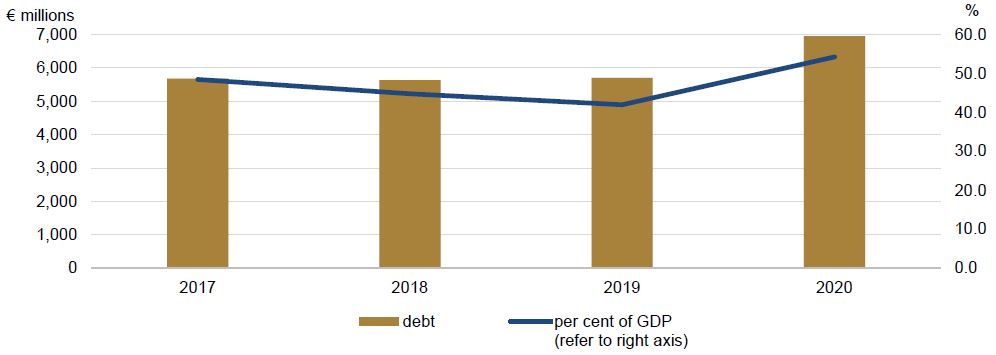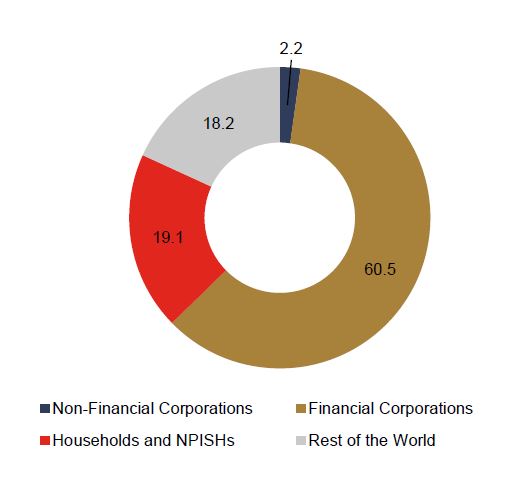A breakdown of Government debt has revealed that the share of Malta’s Government debt that is owned by non-local agents has increased markedly in recent years, almost doubling in nominal terms since 2017.
This is in contrast with the amount of debt held by households, which has been on a slow but steady decline since the same year.
The figures emerge from a National Statistics Office (NSO) release, published on Tuesday, which notes that the total amount of General Government debt as at the end of 2020 amounted to €6,960 million, or 54.3 per cent of GDP, an increase of €1,257.2 million over 2019.

Financial Corporations held the biggest share of debt, with 60.5 per cent, followed by Households and Non-Profit Institutions Serving Households (NPISH) with 19.1 per cent.
The share of the Rest of the World was 18.2 per cent, an increase of 6.1 percentage points over the debt held in 2017, while the Non-Financial Corporations sector held 2.2 per cent of the debt.

Debt securities, which include Malta Government Stocks and Treasury Bills, are by far the preferred debt instrument for General Government, with €5,945.1 million, or 85.4 per cent, of the total debt in 2020. Other debt instruments are Loans and Currency, with 7.8 per cent and 6.8 per cent, respectively.
The increase reported under Debt securities (€1,030.0 million) mainly relates to the financing of the Government’s COVID-19 measures, while the increases in Loans (€135.7 million) and Currency (€91.9 million) mainly represent the EU loan from the temporary Support to mitigate Unemployment Risks in an Emergency (SURE) instrument and the issuance of the 62+ Malta Government Savings Bonds, respectively.
Almost all the debt owed by the General Government Sector is in national currency. The stock of debt in foreign currencies has decreased considerably over the years and in 2020 it amounted to €0.1 million.
The apparent cost of debt, which is the interest rate applicable to the whole nominal debt, was 2.7 per cent in 2020, compared to 3.7 per cent in 2017.
This measure of the cost of debt reflects the interest rates prevailing at the issuance date and, given that the composition of debt is predominantly long-term, the indicator is not very sensitive to the more recent low interest rate scenario.
For 2020, the market value of the total General Government debt is estimated at €8,178.4 million, compared to the nominal value of €6,960.0 million. Market debt increased by €1,245.8 million over 2019, slightly lower when compared to the increase of €1,257.2 million in nominal debt.
For the year under review, the time structure of the debt by initial maturity shows that €3,228.7 million, or 46.4 per cent, was issued with a maturity of 15 to 30 years. This was followed by debt issued for one to five years (13.3 per cent), 5 to 7 years (13.1 per cent), less than one year (10.2 per cent), 10 to 15 years (9.8 per cent), seven to 10 years (6.0 per cent) and more than 30 years (1.1 per cent).
The average remaining maturity of total debt for 2020 was eight years eight months, three months shorter than in 2019 and nine months shorter than in 2017. In 2020, the biggest share of debt by remaining maturity was in the one-to-five-year category with €1,904.2 million, followed by the seven-to-10-year (€1,351.9 million) and the less than one year (€1,169.1 million) categories.
Government guarantees on borrowing amounted to €1,172.6 million in 2020, or 9.1 per cent of GDP, an increase of €182.4 million over 2019. The majority of Government guarantees are issued towards the Non-Financial Corporations sector, which accounts for 63.3 per cent of the total guarantees. The Financial Corporations, Rest of the World and NPISH sectors benefitted from 33.9, 2.0 and 0.8 per cent of Government guarantees, respectively. The Government guarantees are contingent liabilities, contingent on the actual call of the guarantee, and therefore these do not form part of General Government debt.
Malta’s inflation edges up to 2.7% in October as food and services lead price pressures
The October RPI reading indicates some re-acceleration in consumer-facing sectors after a period of summer stabilisation
db Group reports turnover of almost €100 million and record profit as it opens bond issue to public investors
This coincides with the launch of a €60 million bond programme to support the Group’s continued expansion
Celebrating success: stories from the team behind Finco Trust
The stories of Lee-Anne Abela, Kris Vella, and Maria Mamo reflect the values that continue to guide the firm forward






